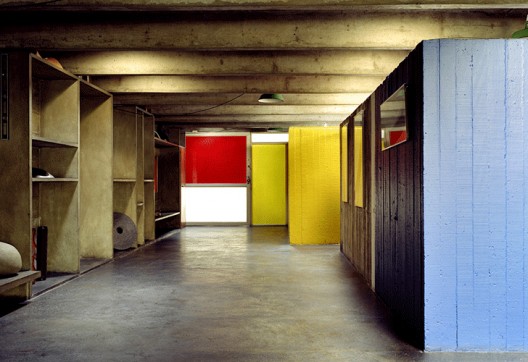Final Brief
The client - Ruy Ohtake, The architect
The Japanese artist Tomie Ohtake traveled to Brazil in 1936, but due to World War II, she could not return. In 1951 she started painting and latter became a rewarded artist with work featured in several cities in Brazil, but mainly in the state of São Paulo. (#1)
In 1938 the son of Tomie Ohtake, Ruy Ohtake, was born in the Móoca neighborhood of São Paulo (#2). Ruy majored in Architecture at the University of São Paulo at the age of 22 (1960), where he later went on to teach as full professor. Just the year after he graduated, in 1961, Ruy started his private practice which is the origin of the works he is so famous for.
Lets look at two statements made by Ruy Ohtake.
"Architecture cannot be understood in itself, because it is a central component in the complex social structure of a country. The level of social equity is always reflected in the architectural production. The more equitable and just the society, the more interesting its architecture.""The extreme unevenness of the Brazilian society is very unpleasant, but it cannot be forgotten, because it influences the whole architectural process." (#3)
"Architecture cannot be understood in itself, because it is a central component in the complex social structure of a country. The level of social equity is always reflected in the architectural production. The more equitable and just the society, the more interesting its architecture.""The extreme unevenness of the Brazilian society is very unpleasant, but it cannot be forgotten, because it influences the whole architectural process." (#3)
Brazil currently has around 200 million citizens (#4), a lot of them living in the bigger cities as Rio de Janeiro and São Paulo where the population density is very high, especially in the suburbs. He mentions the unevenness and equity of a society as important factors for the architecture. Ruy Ohtake is clearly influenced by the poverty and unevenness of the Brazilian society. The question is if it good way since he says that the more equitable and just a society, the more interesting is its architecture. He is probably referring to Brazil/São Paulo as a whole because the architecture of Ruy Ohtake is definitely interesting.
Ohtake says that his main goal when contributing to Brazilian architecture has been to reflect the Brazilian culture in his architecture like the Bossanova (Brazilian music genre which among other things produced the Garota de Ipanema - The girl from Ipanema) once did. The element of the liveliness of the Brazilian people is clearly integrated in the buildings of Ruy Ohtake. An example of this is seen in the Brazilian Embassy in Tokyo, which Ruy has designed.
 |
| #1 - Exterior of the Brazilian Embassy in Tokyo |
 |
| #2 - Interior of the Brazilian Embassy in Tokyo |
As seen on the above images of the embassy, Ruy Ohtake uses curves a lot in his architecture. Ruy Othake says the following about curves (#3):
"I like curves, all types of curves. I have been using them since my earliest projects. But the one I am constantly searching is that of surprise, of the unexpected.The unexpected curve is the one that makes us follow it with our eyes through all its extension, because we know it can change at any moment"
We clearly see this in all of Ruy's architecture, and it is actually quite common in Brazilian architecture to move away from the frames of regular geometry.
#3 - Examples of the usage of curves
Ruy Ohtake makes some very interesting external facades, but his interior is just as interesting. Here are some examples from the resident of his mother, Tomie Ohtake, which he has designed.
 |
| #4,5,6 - Interior design of Residensia de Tomie Ohtake |
The brief
The rooms
- Master bedroom (with walk in robe and ensuite)
- minimum two other general bedrooms
- a bathroom associated with these two bedrooms
- must include a bath and a seperate shower
- Guest bedroom
- A studio for drawing and art projects, music, etc
- Combined dining/kitchen area
- Playroom for kids playfully integrated to the living room
- WC
- Kitchen
- double wall oven
- 2 bowl sink one an island benchtop
- island benchtop with free standing range hood
- Laundry (sufficient to do washing, ironing, etc inside the room)
- 2 car garage (with additional storage space)
Relationships
- Bedrooms should be grouped together, although the study / guest bedroom should be associated with the public areas of the house rather than the other bedrooms. Nevertheless, ensure that this room is also able to maintain some degree of privacy when in use by guests.
- Open walk in robe
- would like a small balcony off of the master bedroom with vegetation
- Dining room area should be center of the house
- kids play room to be associated with bedrooms 2+3
- garage to have internal access from house
Design comments
- Want a WOW! reaction when visitors enter our home
- Focus on natural lights - windows and skylights!
- Big open high-ceiling spaces
- Could have a spiral stairway to suit Ruy Ohtakes curvy shapes
- Raw materials like concrete and steel
- Outdoor shower for showering after going to the beach
- want a house that is warm in winter and cool in summer, and inexpensive to run
- ensuite does not need a bath tub, but should have a large shower, with a waterfall rose and an adjustable rose
- master bedroom should have a view towards Edwards Beach
- king size bed in the master bedroom
- Laundry should be big enough to work in effectively
Sources:
#2: http://en.wikipedia.org/wiki/Ruy_Ohtake
#3: http://www.reocities.com/capitolhill/3836/saopaulo.html
#3: http://www.reocities.com/capitolhill/3836/saopaulo.html
Image sources:




